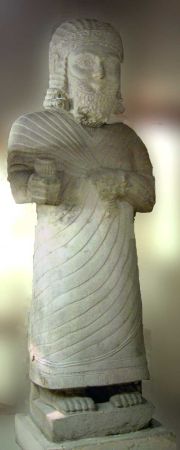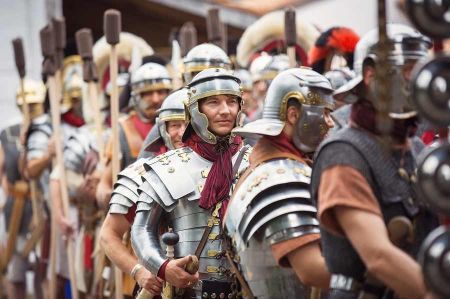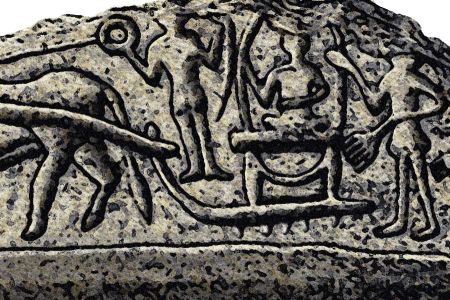Malatya - former Hethitian Melid then Assyrian city
- Written by Portal Editor
The Hittites had already settled in the region around Malatya and founded a settlement called Melid, which in Hittite means something like honey and was probably a synonym for the economic importance of the settlement.
It is even probable that there were settlements in the Melid area before the Hittites. In Hittite times called Melid, then Melitene and today the Turks call the place Arslantepe.
With the fall of the Hittite Empire, Melid was also ruled by a grandson of Šuppiluliuma II, Kuzi-Teššups of Karkemiš, who was considered the last ruler of the Hittite Empire. Its territory extended across the Malatya plain on the western bank of the Euphrates to Elbistan. In the east the government area of Išuwa was limited.
King Shalmaneser II takes power
 Under the Assyrian King Shalmaneser II, some campaigns from the years 844, 836 and 835 against the region around Melid are documented, so that the influence of the Assyrians increased noticeably. Under the ruler Tukulti-apil-Ešarra III, Melid even had to pay tribute. When the Assyrian Empire was under pressure from the Urartu Empire around 800 BC, Sargon II decided to hand over the city of Melid to the King of Kummuh. In 708 BC Melid was placed directly under Assyrian rule, which, however, just lasted for 3 years. The Assyrian names of the city as Meliddu, Melide, Milid or Milidia come from this era. Campaigns directed against Melid are also known among the rulers Sennacherib and Assurhaddon. In the end, Melid is even burned down by the Assyrians. Only few remnants still point to this once flourishing city, a place that is now called Arslantepe. The new city, which initially continues to be called Melid, will be rebuilt elsewhere by the old former residents.
Under the Assyrian King Shalmaneser II, some campaigns from the years 844, 836 and 835 against the region around Melid are documented, so that the influence of the Assyrians increased noticeably. Under the ruler Tukulti-apil-Ešarra III, Melid even had to pay tribute. When the Assyrian Empire was under pressure from the Urartu Empire around 800 BC, Sargon II decided to hand over the city of Melid to the King of Kummuh. In 708 BC Melid was placed directly under Assyrian rule, which, however, just lasted for 3 years. The Assyrian names of the city as Meliddu, Melide, Milid or Milidia come from this era. Campaigns directed against Melid are also known among the rulers Sennacherib and Assurhaddon. In the end, Melid is even burned down by the Assyrians. Only few remnants still point to this once flourishing city, a place that is now called Arslantepe. The new city, which initially continues to be called Melid, will be rebuilt elsewhere by the old former residents.
The rule over Melitene / Malatya was very changeable in the following centuries, from Persians and Seleucids to the Romans, who moved the headquarters of the Legio XII Fulminata here. When Eustathius of Sebaste was deposed during the local synod in 358, this event also took place in Melitene. Later, in the year 575, the Byzantine general Justinian was able to defeat the Persian great king Chosrau I in the famous battle of Melitene. Melitene fell to the Seljuks for the first time in 1069.
Famous infamous Battle of Manzikert
 After the victory of the Byzantine general Philaretos Brachamios during the famous battle of Manzikert in 1071, Melitene again came under the control of Byzantium. With the death of the general in 1090, the Armenian ruler Gabriel took power and established connections to the emerging crusader states. When the Danishmedes were able to conquer Melitene in 1103, Gabriel was also killed during the fighting. Just three years later, the Seljuq prince Kılıç Arslan I was able to conquer Melitene. His death in 1107 and the capture of his son Malik Shah I made the youngest son Toghrul Arslan as well as his mother and her new husband, the Ortogride Balak Ibn Bahram, the ruling family. In 1124 Melitene could be recaptured by the Emir Ghazi for the Danischmedes. In this battle for the city Balak died too. Since the Emir Ghazi was regarded as a mild and fair ruler, the local Christians were also very satisfied with Emir Ghazi taking power.
After the victory of the Byzantine general Philaretos Brachamios during the famous battle of Manzikert in 1071, Melitene again came under the control of Byzantium. With the death of the general in 1090, the Armenian ruler Gabriel took power and established connections to the emerging crusader states. When the Danishmedes were able to conquer Melitene in 1103, Gabriel was also killed during the fighting. Just three years later, the Seljuq prince Kılıç Arslan I was able to conquer Melitene. His death in 1107 and the capture of his son Malik Shah I made the youngest son Toghrul Arslan as well as his mother and her new husband, the Ortogride Balak Ibn Bahram, the ruling family. In 1124 Melitene could be recaptured by the Emir Ghazi for the Danischmedes. In this battle for the city Balak died too. Since the Emir Ghazi was regarded as a mild and fair ruler, the local Christians were also very satisfied with Emir Ghazi taking power.
With the Mongol invasion in 1243, many residents of Melitenes tried their luck in fleeing to Syria but were almost entirely captured. It was just the intervention of the Syrian metropolitan Dionysus that a peace agreement was reached with the Mongols, under which Melitene was also handed over to the Mongols without being plundered.
Since 1273 Melitene has been repeatedly attacked by Arabs and countless inhabitants of the surrounding villages sold as slaves. In 1516 Malatya finally fell to the Ottomans.
The modern Malatya is consequently already the third city that was always rebuilt only a few kilometres from the old settlement: after the ancient Melid of the Hittites, today's Arslantepe and the medieval Melitene, the place became Malatya. In the vernacular often still referred to as Old Malatya (Eskimalatya), the old Malatya is now called Battalgazi.
Please read as well:
Prague - walking tour of the historic old town
Meteora - THe ideal place for climbing enthusiasts
